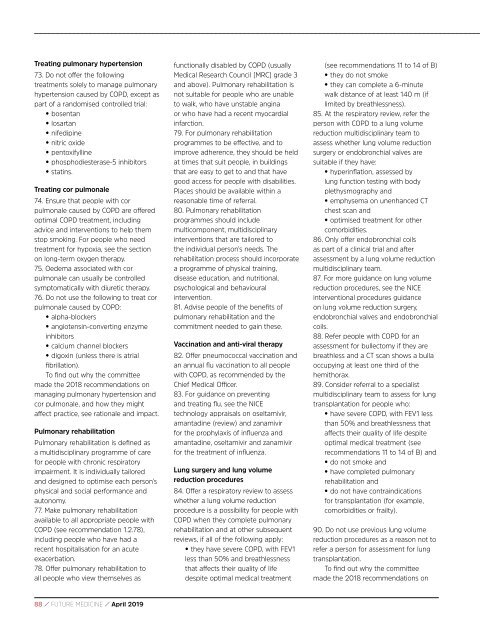You also want an ePaper? Increase the reach of your titles
YUMPU automatically turns print PDFs into web optimized ePapers that Google loves.
Treating pulmonary hypertension<br />
73. Do not offer the following<br />
treatments solely to manage pulmonary<br />
hypertension caused by COPD, except as<br />
part of a randomised controlled trial:<br />
• bosentan<br />
• losartan<br />
• nifedipine<br />
• nitric oxide<br />
• pentoxifylline<br />
• phosphodiesterase‐5 inhibitors<br />
• statins.<br />
Treating cor pulmonale<br />
74. Ensure that people with cor<br />
pulmonale caused by COPD are offered<br />
optimal COPD treatment, including<br />
advice and interventions to help them<br />
stop smoking. For people who need<br />
treatment for hypoxia, see the section<br />
on long-term oxygen therapy.<br />
75. Oedema associated with cor<br />
pulmonale can usually be controlled<br />
symptomatically with diuretic therapy.<br />
76. Do not use the following to treat cor<br />
pulmonale caused by COPD:<br />
• alpha-blockers<br />
• angiotensin-converting enzyme<br />
inhibitors<br />
• calcium channel blockers<br />
• digoxin (unless there is atrial<br />
fibrillation).<br />
To find out why the committee<br />
made the 2018 recommendations on<br />
managing pulmonary hypertension and<br />
cor pulmonale, and how they might<br />
affect practice, see rationale and impact.<br />
Pulmonary rehabilitation<br />
Pulmonary rehabilitation is defined as<br />
a multidisciplinary programme of care<br />
for people with chronic respiratory<br />
impairment. It is individually tailored<br />
and designed to optimise each person's<br />
physical and social performance and<br />
autonomy.<br />
77. Make pulmonary rehabilitation<br />
available to all appropriate people with<br />
COPD (see recommendation 1.2.78),<br />
including people who have had a<br />
recent hospitalisation for an acute<br />
exacerbation.<br />
78. Offer pulmonary rehabilitation to<br />
all people who view themselves as<br />
functionally disabled by COPD (usually<br />
Medical Research Council [MRC] grade 3<br />
and above). Pulmonary rehabilitation is<br />
not suitable for people who are unable<br />
to walk, who have unstable angina<br />
or who have had a recent myocardial<br />
infarction.<br />
79. For pulmonary rehabilitation<br />
programmes to be effective, and to<br />
improve adherence, they should be held<br />
at times that suit people, in buildings<br />
that are easy to get to and that have<br />
good access for people with disabilities.<br />
Places should be available within a<br />
reasonable time of referral.<br />
80. Pulmonary rehabilitation<br />
programmes should include<br />
multicomponent, multidisciplinary<br />
interventions that are tailored to<br />
the individual person's needs. The<br />
rehabilitation process should incorporate<br />
a programme of physical training,<br />
disease education, and nutritional,<br />
psychological and behavioural<br />
intervention.<br />
81. Advise people of the benefits of<br />
pulmonary rehabilitation and the<br />
commitment needed to gain these.<br />
Vaccination and anti-viral therapy<br />
82. Offer pneumococcal vaccination and<br />
an annual flu vaccination to all people<br />
with COPD, as recommended by the<br />
Chief Medical Officer.<br />
83. For guidance on preventing<br />
and treating flu, see the NICE<br />
technology appraisals on oseltamivir,<br />
amantadine (review) and zanamivir<br />
for the prophylaxis of influenza and<br />
amantadine, oseltamivir and zanamivir<br />
for the treatment of influenza.<br />
Lung surgery and lung volume<br />
reduction procedures<br />
84. Offer a respiratory review to assess<br />
whether a lung volume reduction<br />
procedure is a possibility for people with<br />
COPD when they complete pulmonary<br />
rehabilitation and at other subsequent<br />
reviews, if all of the following apply:<br />
• they have severe COPD, with FEV1<br />
less than 50% and breathlessness<br />
that affects their quality of life<br />
despite optimal medical treatment<br />
(see recommendations 11 to 14 of B)<br />
• they do not smoke<br />
• they can complete a 6‐minute<br />
walk distance of at least 140 m (if<br />
limited by breathlessness).<br />
85. At the respiratory review, refer the<br />
person with COPD to a lung volume<br />
reduction multidisciplinary team to<br />
assess whether lung volume reduction<br />
surgery or endobronchial valves are<br />
suitable if they have:<br />
• hyperinflation, assessed by<br />
lung function testing with body<br />
plethysmography and<br />
• emphysema on unenhanced CT<br />
chest scan and<br />
• optimised treatment for other<br />
comorbidities.<br />
86. Only offer endobronchial coils<br />
as part of a clinical trial and after<br />
assessment by a lung volume reduction<br />
multidisciplinary team.<br />
87. For more guidance on lung volume<br />
reduction procedures, see the NICE<br />
interventional procedures guidance<br />
on lung volume reduction surgery,<br />
endobronchial valves and endobronchial<br />
coils.<br />
88. Refer people with COPD for an<br />
assessment for bullectomy if they are<br />
breathless and a CT scan shows a bulla<br />
occupying at least one third of the<br />
hemithorax.<br />
89. Consider referral to a specialist<br />
multidisciplinary team to assess for lung<br />
transplantation for people who:<br />
• have severe COPD, with FEV1 less<br />
than 50% and breathlessness that<br />
affects their quality of life despite<br />
optimal medical treatment (see<br />
recommendations 11 to 14 of B) and<br />
• do not smoke and<br />
• have completed pulmonary<br />
rehabilitation and<br />
• do not have contraindications<br />
for transplantation (for example,<br />
comorbidities or frailty).<br />
90. Do not use previous lung volume<br />
reduction procedures as a reason not to<br />
refer a person for assessment for lung<br />
transplantation.<br />
To find out why the committee<br />
made the 2018 recommendations on<br />
88 / FUTURE MEDICINE / <strong>April</strong> <strong>2019</strong>


















